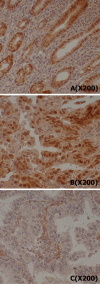Expression of Krüppel-like factor 5 in human gastric carcinomas
- PMID: 17622557
- PMCID: PMC12161671
- DOI: 10.1007/s00432-007-0265-2
Expression of Krüppel-like factor 5 in human gastric carcinomas
Abstract
Purpose: Krüppel-like factor 5 (KLF5) is a zinc finger transcription factor, which has recently attracted attention because of its important regulatory activities linked to diverse functions such as cell growth, proliferation, differentiation, and tumorigenesis in a number of systems. However, its expression in human gastric cancer has not been described previously. In this study, we investigated the expression profile of KLF5 and the relationship between its clinicopathologic features and expression in gastric carcinomas.
Methods: Tissues were obtained from 247 gastric carcinoma patients who underwent curative gastrectomy (R0 resection) at the Department of Surgery, Seoul National University Hospital from January 1995 to June 1995, and these tissues were arranged in tissue array blocks. KLF5 expression was analyzed by immunohistochemical staining using anti-BTEB2 mouse monoclonal antibodies (Santa Cruz Biotechnology Inc., Santa Cruz, CA, USA).
Results: Overall KLF5 was found to be expressed in 45.7% (113/247) of tumor tissues. Moreover, its expression rate was significantly high in early-staged gastric cancer (63.2 vs. 38.0%, p < 0.001), in gastric cancer without lymph node metastasis (54.0 vs. 40.1%, p = 0.04), and in tumors <5 cm in size (53.0 vs. 38.1%, p = 0.02). The 5-year survival rate of patients with KLF5-positive tumors was higher than those of patients with KLF5-negative tumors, although this was not statistically significant (74.7 vs. 62.2%, p = 0.057).
Conclusion: KLF5 expression rate was high in early-staged gastric cancer, in small gastric cancer tissues and in gastric cancer without lymph node metastasis. By univariate analysis, its expression was found to favor survival after surgery. Our study describes for the first time the expression profile of KLF5 in a large number of human gastric cancer tissues and suggests consistent results shown in many recent studies that reduction of KLF5 expression occurs in many types of human tumor.
Figures


Similar articles
-
Diagnostic accuracy of endoscopic ultrasonography (EUS) for the preoperative locoregional staging of primary gastric cancer.Cochrane Database Syst Rev. 2015 Feb 6;2015(2):CD009944. doi: 10.1002/14651858.CD009944.pub2. Cochrane Database Syst Rev. 2015. PMID: 25914908 Free PMC article.
-
Expression of gastrin and its receptor in human gastric cancer tissues.J Cancer Res Clin Oncol. 2006 Feb;132(2):85-91. doi: 10.1007/s00432-005-0043-y. Epub 2005 Oct 14. J Cancer Res Clin Oncol. 2006. PMID: 16228228 Free PMC article.
-
[Application research of endoscopic-laparoscopic regional gastric resection combined with sentinel lymph node basin dissection in patients with early gastric cancer].Zhonghua Wai Ke Za Zhi. 2025 Jul 1;63(7):587-596. doi: 10.3760/cma.j.cn112139-20250117-00034. Zhonghua Wai Ke Za Zhi. 2025. PMID: 40443334 Chinese.
-
Lymphatic and/or blood vessel invasion in gastric cancer: relationship with clinicopathological parameters, biological factors and prognostic significance.J Cancer Res Clin Oncol. 2008 Feb;134(2):153-61. doi: 10.1007/s00432-007-0264-3. Epub 2007 Jul 13. J Cancer Res Clin Oncol. 2008. PMID: 17628829 Free PMC article.
-
Single-incision sling operations for urinary incontinence in women.Cochrane Database Syst Rev. 2017 Jul 26;7(7):CD008709. doi: 10.1002/14651858.CD008709.pub3. Cochrane Database Syst Rev. 2017. Update in: Cochrane Database Syst Rev. 2023 Oct 27;10:CD008709. doi: 10.1002/14651858.CD008709.pub4. PMID: 28746980 Free PMC article. Updated.
Cited by
-
The role of Krüppel-like factors in the reprogramming of somatic cells to induced pluripotent stem cells.Histol Histopathol. 2009 Oct;24(10):1343-55. doi: 10.14670/HH-24.1343. Histol Histopathol. 2009. PMID: 19688699 Free PMC article. Review.
-
Krüppel-like factors 4 and 5: unity in diversity.Curr Genomics. 2009 Dec;10(8):594-603. doi: 10.2174/138920209789503932. Curr Genomics. 2009. PMID: 20514221 Free PMC article.
-
Clinical Significance of Lysophosphatidic Acid Receptor-2 (LPA2) and Krüppel-Like Factor 5 (KLF5) Protein Expression Detected by Tissue Microarray in Gastric Adenocarcinoma.Med Sci Monit. 2019 Jun 25;25:4705-4715. doi: 10.12659/MSM.916336. Med Sci Monit. 2019. PMID: 31235682 Free PMC article.
-
Haploinsufficiency of Krüppel-like factor 5 rescues the tumor-initiating effect of the Apc(Min) mutation in the intestine.Cancer Res. 2009 May 15;69(10):4125-33. doi: 10.1158/0008-5472.CAN-08-4402. Epub 2009 May 12. Cancer Res. 2009. PMID: 19435907 Free PMC article.
-
Evasion of anti-growth signaling: A key step in tumorigenesis and potential target for treatment and prophylaxis by natural compounds.Semin Cancer Biol. 2015 Dec;35 Suppl:S55-S77. doi: 10.1016/j.semcancer.2015.02.005. Epub 2015 Mar 6. Semin Cancer Biol. 2015. PMID: 25749195 Free PMC article. Review.
References
-
- Bateman NM, Tan D, Pestell RG, Black JD, Balck AR (2004) Intestinal tumor progression is associated with altered function of KLF5. J Biol Chem 279:12093–12101 - PubMed
-
- Black AR, Black JD, Azizkhan-Clifford J (2001) Sp1 and Krüppel-like factor family of transcription factors in cell growth regulation and cancer. J Cell Physiol 188(2):143–160 - PubMed
-
- Bloethner S, Chen B, Hemminki K, Muller-Berghaus J, Ugurel S, Schadendorf D, Kumar R (2005) Effect of common B-RAF and N-RAS mutations on global gene expression in melanoma cell lines. Carcinogenesis 26(7):1224–1232 - PubMed
-
- Chen C, Bhalala HV, Qiao H, Dong JT (2002) A possible tumor suppressor role of the KLF5 transcription factor in human breast cancer. Oncogene 20:6567–6572 - PubMed
Publication types
MeSH terms
Substances
LinkOut - more resources
Full Text Sources
Medical

